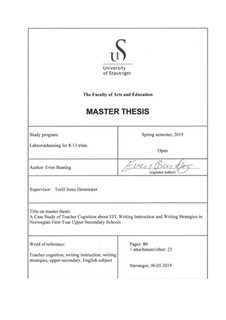| dc.description.abstract | The present qualitative case study explores teacher cognition (beliefs, attitudes, knowledge and practices) in relation to writing instruction and the instruction of writing strategies in the English subject in first-year upper-secondary English as a Foreign Language (EFL) classrooms. The data collection consisted of qualitative methods, namely semi-structured interviews and classroom observations. The sample consisted of two teachers who taught the first-year English subject in the general study programme (VG1) and one teacher who taught the first-year English subject in sports education (VG1). The study investigated three research questions: (1) What characterises the teachers EFL writing instructions? (2) To what extent do they teach their students writing strategies? (3) How do their beliefs and practices compare with the current research literature on writing instruction?
The Norwegian curriculum (LK06) has writing as one of its five basic skills, emphasising writing to be a tool for organising and developing one’s thoughts in the learning process and stresses the ability to plan, construct, and revise texts relevant to purpose and audience (Norwegian Directorate for Education and Training, 2012, p. 10). Furthermore, in connection with the new and revised Core Curriculum, NOU’s chosen committee stated that language competence should remain in all subjects and be further developed (Kunnskapsdepartementet, 2015). Additionally, the English subject curriculum emphasises vocabulary, writing different texts with suitable structure and coherence, producing different kinds of texts (digital), and using suitable writing strategies for the purpose and type of text. However, there is no precise information on how to instruct writing or what types of texts students are to write. The Framework for Basic Skills mentions writing instruction, although it only addresses developing orthography, functional handwriting and use of keyboard concerning planning, and writing simple, clear texts for different purposes (Norwegian Directorate for Education and Training, 2012, p. 10). Hence, because teachers are given autonomy to choose types of texts, material, writing strategies, approaches, and topics related to the English subject, the study has attempted to study the teachers’ reasoning for writing instruction and their instructions related to writing strategies. To best accommodate the teachers’ cognitions, current practices were studied concerning their attitudes, beliefs, and knowledge.
The study found that the participants were influenced in varying degrees by their own experiences as language learners and their teacher education. The teachers also noted their experience as teachers to be vital in their development as teachers. Moreover, the results indicate that some of their experiences as language learners have direct connections to what they emphasise and incorporate in their lessons. However, the influence varied from prior knowledge about writing instruction in both upper-secondary school and in higher education Also the influences were both from the teachers’ L1 and EFL prior writing instruction.
The teachers were influenced to varying degrees when it comes to the curriculum aims in connection with their instructional decisions and choice of material. However, these legal steering documents affected all of the teachers and functioned as guiding elements to their instructional decisions and material choice. Moreover, two of the teachers noted factors such as colleagues as affecting their material and instructional decisions. The teachers seemed to use the textbook to a low degree, and one of them discarded it.
Evidently, the teachers shared common beliefs about the importance of structure, language, and variation when teaching writing. However, they practised their lessons differently from each other, but employed similar approaches to their stated beliefs. The teachers reported and employed approaches similar to the core values of process-oriented writing (POW) and the genre-based approach. Furthermore, all of the teachers reported the employment of multimodal texts, but varied in quantity of types.
All of the teachers reported prioritising essay writing, where two of them explicitly emphasised the five-paragraph essay. The primary genre instructed was argumentative texts in the belief that it would ease writing for a potential written exam. In this connection, most of the writing strategies employed consisted of providing rhetorical refining, suitable words and phrases, pre-writing exercises, and revision. The teachers also employed cooperative revision, and one of them employed joint construction of a text (paragraph).
The present thesis has hopefully contributed to the research on teacher cognition and writing instruction and instruction of writing strategies in the Norwegian first-year of upper-secondary level. | nb_NO |
